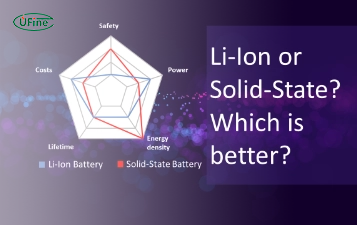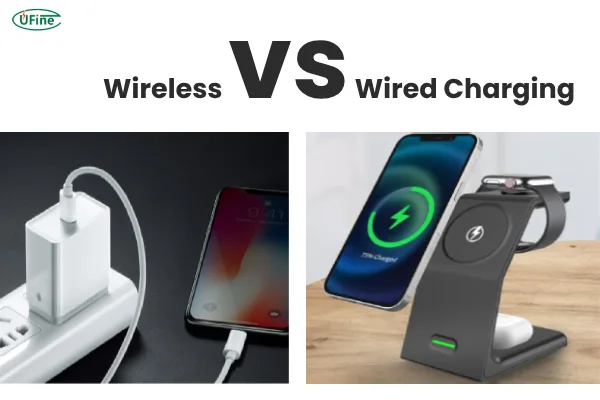
- Part 1. Understanding the fundamentals
- Part 2. Charging efficiency
- Part 3. Charging speed and power output
- Part 4. Safety and battery health
- Part 5. Design and integration flexibility
- Part 6. Cost and infrastructure
- Part 7. Application-specific use cases
- Part 8. Conclusion: which one is better for lithium batteries?
In the world of portable electronics, electric vehicles (EVs), smart devices, and industrial systems, lithium batteries have become the gold standard for energy storage. As these batteries power an increasing number of devices, how we recharge them has evolved. Wired charging remains the traditional method, but wireless charging has emerged as a modern alternative offering convenience and design flexibility.
This article presents a comprehensive comparison between wireless and wired charging of lithium batteries. Covering at least 7 detailed parts, we will explore everything from basic principles to charging speed, efficiency, safety, device design, and real-world applications. Whether you’re a tech professional, product developer, or an enthusiast, this in-depth guide will help you understand which method suits your use case better.
Part 1. Understanding the fundamentals
1.1 Wired Charging: Direct Electrical Conduction
Wired charging is the standard and most widely adopted charging method. It involves:
- A power source (e.g., wall adapter or USB port)
- A cable (USB-A, USB-C, Lightning, etc.)
- A battery management system (BMS) in the device
The charger converts AC power into DC, which is transferred via a cable to the lithium battery. The BMS controls the current and voltage, ensuring the battery is charged safely using a constant current–constant voltage (CC–CV) protocol.
1.2 Wireless Charging: Electromagnetic Induction
Wireless charging—also known as inductive charging—uses magnetic fields to transfer energy. It consists of:
- A transmitting coil (in the charging pad)
- A receiving coil (in the device)
- A magnetic field that transfers energy between them
The transmitter generates an alternating current, creating a magnetic field that induces a current in the receiving coil. This AC current is then rectified into DC to charge the battery.
Some advanced wireless charging systems use resonant induction, capacitive coupling, or even radio frequency (RF) charging. However, for lithium batteries in consumer electronics, inductive charging (Qi standard) is the most common.
Part 2. Charging efficiency
2.1 Wired Charging Efficiency (90–95%)
Wired charging has the highest energy efficiency:
- Minimal energy is lost during conduction
- Less conversion overhead
- Power loss mainly occurs due to heat in the cable or internal resistance
High-quality wired chargers and cables can deliver efficiency of up to 95%, which is ideal for devices requiring fast, stable charging like laptops, power tools, or EVs.
2.2 Wireless Charging Efficiency (60–80%)
Wireless charging suffers from greater energy loss due to:
- Electromagnetic field dispersion
- Heat generated from coil misalignment or magnetic resistance
- Additional circuitry to manage AC/DC conversion and alignment
Most commercial wireless chargers operate at 60–80% efficiency, though premium devices claim up to 85% under perfect alignment. These losses translate into longer charging times and increased energy consumption over time.
Part 3. Charging speed and power output
3.1 Wired Charging: Superior Speed and Control
Wired chargers support much higher power output and faster charging protocols:
- USB-C Power Delivery (PD): Up to 240W
- Qualcomm Quick Charge: Up to 100W
- EV chargers: 50kW to over 350kW
Charging speed depends on the battery’s capacity, health, thermal limits, and the charger’s current capabilities. For lithium batteries, fast charging is achieved with controlled voltage and higher current during the constant current phase.
Example: A 4000mAh Li-ion battery with a 20W wired charger may charge from 0% to 80% in under 30 minutes.
3.2 Wireless Charging: Limited by Heat and Alignment
Wireless charging typically ranges from:
- 5W to 15W for smartphones
- 1W to 5W for wearables
- 11kW to 22kW (experimental) for electric vehicles
Despite recent advances, thermal buildup is a limiting factor. To protect the battery, the system automatically reduces power output when heat exceeds safe levels. Coil misalignment further reduces charging speed.
Example: The same 4000mAh battery may take 60 to 90 minutes for a full charge on a 10W wireless pad.
Part 4. Safety and battery health
4.1 Wired Charging Risks
Wired charging is generally safe, but low-quality or incompatible chargers can pose risks:
- Voltage spikes or surges
- Short circuits
- Overheating due to overcurrent
- Connector damage over time
High-quality chargers use integrated safety protocols such as:
- Over-voltage protection
- Over-current protection
- Thermal monitoring
Improper use can shorten lithium battery lifespan and in extreme cases, lead to thermal runaway (especially in high-density LiPo packs).
4.2 Wireless Charging Safety Considerations
Wireless systems eliminate the need for exposed contacts, making them:
- Safer in wet or dusty environments
- Resistant to corrosion and mechanical wear
However, they also generate more heat, which is detrimental to lithium batteries over time. Continuous use of wireless charging can:
- Accelerate battery aging
- Lead to capacity fade
- Increase internal resistance
Modern wireless chargers use technologies like Foreign Object Detection (FOD), temperature sensors, and adaptive alignment to mitigate risks.
Part 5. Design and integration flexibility
5.1 Wireless Charging: Enabler of Minimalism
Wireless charging is transforming device design. It enables:
- Portless and seamless devices
- Waterproof and dustproof enclosures
- Simplified user interfaces
Devices like smartwatches, earbuds, and high-end smartphones (e.g., iPhone, Samsung Galaxy) benefit from wireless charging’s convenience and aesthetic potential.
This also opens doors for:
- Medical devices that must remain sealed
- Industrial sensors in harsh environments
- IoT devices where maintenance is difficult
5.2 Wired Charging: Universal and Practical
While less futuristic, wired charging is:
- Cheaper to implement
- Easier to troubleshoot
- Compatible with standardized ports
USB-C, in particular, supports data transfer, video output, and high-speed charging—making it a multi-functional port for both consumer and industrial applications.
Part 6. Cost and infrastructure
6.1 Wired Charging: Low Cost and Mature Infrastructure
Wired charging components—adapters, cables, connectors—are:
- Inexpensive
- Mass-produced
- Easy to replace
Charging infrastructure is widely available:
- USB ports in homes, offices, vehicles
- DC fast chargers for EVs
- Laptop chargers and power banks
For most devices, wired charging remains the most cost-effective and scalable solution.
6.2 Wireless Charging: Premium and Limited
Wireless charging modules require:
- Transmitter and receiver coils
- Rectifiers and inductors
- Alignment hardware
This makes them more expensive to design and manufacture. Additionally:
- Public wireless pads are still rare
- Charging requires precise placement
- Multi-device charging is limited by coils and heat dissipation
While wireless infrastructure is growing, especially in premium cars, public venues, and smart furniture, it is not yet mainstream.
Part 7. Application-specific use cases
7.1 Wired Charging Dominates In:
- Electric vehicles (Tesla Superchargers, CCS systems)
- Laptops and tablets
- Drones and robots
- Power tools and industrial equipment
- Medical defibrillators and emergency gear
7.2 Wireless Charging Shines In:
- Smartphones (Qi standard devices)
- Smartwatches and wearables
- Wireless earbuds
- Medical implants
- Public spaces and hospitality (tables, car interiors)
7.3 Hybrid Devices: The Best of Both Worlds
Many modern devices support both wired and wireless charging, offering flexibility:
- Wireless charging for convenience
- Wired charging for speed and travel
Examples:
- Apple iPhones (Lightning + Qi)
- Samsung Galaxy phones (USB-C + wireless fast charge)
- Smartwatches with magnetic docks
Part 8. Conclusion: which one is better for lithium batteries?
The answer depends entirely on your application needs:
| Category | Wired Charging | Wireless Charging |
|---|---|---|
| Efficiency | High (90–95%) | Lower (60–80%) |
| Charging Speed | Fast, high wattage | Slower due to heat limitations |
| Cost | Inexpensive | Higher component costs |
| Battery Health | Controlled and cool | More thermal stress |
| Safety | Connector-dependent | Portless, safer surfaces |
| Portability | Flexible | Convenient but requires pad |
| Design Integration | Requires physical port | Seamless and waterproof |
Final Verdict:
- Choose wired charging when you need speed, efficiency, and low cost
- Choose wireless charging for convenience, sealed designs, and premium UX
- For many modern devices, hybrid solutions offer the most flexibility
Related Tags:
More Articles

Solid State Battery vs Lithium Ion: A Comparative Analysis
Compare solid-state and lithium-ion batteries in safety, energy, charging speed, cost, and lifespan. See which works best for EVs, phones, and storage.
Learn safe LiPo battery storage tips, including charge levels, temperature, and humidity control, to extend battery life and prevent risks.
18650 Battery 4.2V VS 3.7V: What is Different?
Compare 18650 batteries: 4.2V vs 3.7V. Learn what V stands for, voltage differences, charging, applications, and which battery suits your device.
How Long Do Rechargeable AA Batteries Last?
Rechargeable AA batteries last 2–10 years (500–2000 cycles). Compare NiMH vs Lithium, tips to extend life, and when to replace batteries.
Industrial Battery vs. Regular Battery: A Complete Comparison
Compare industrial vs regular batteries by lifespan, performance, and cost. Learn which type suits forklifts, solar systems, tools, or common household devices.



